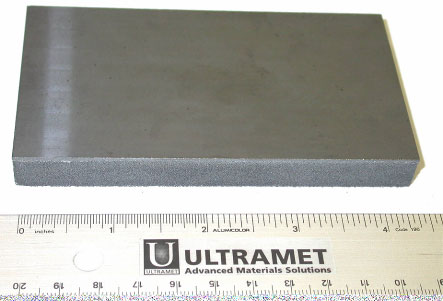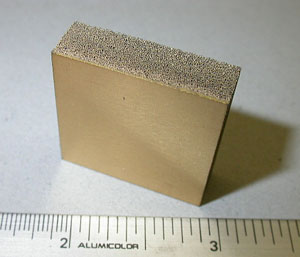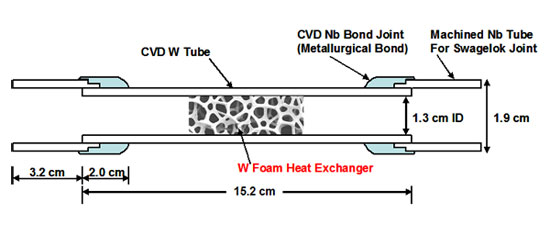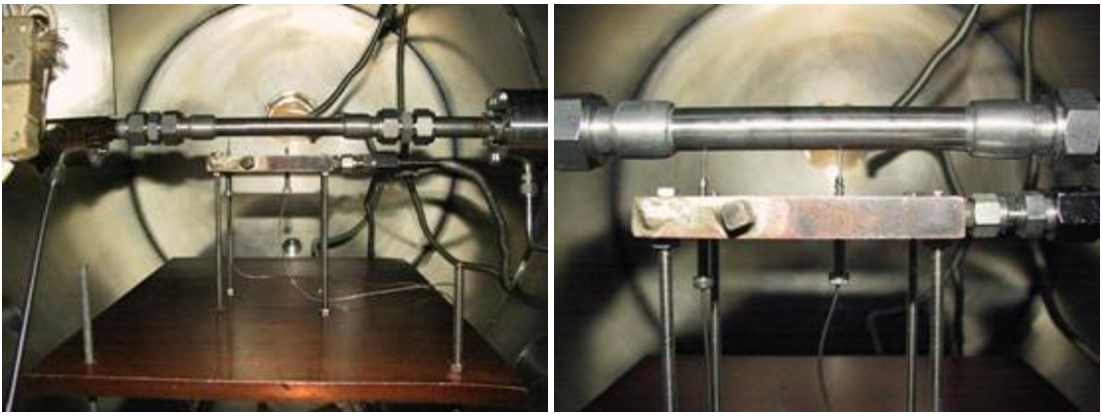Thermal Management
Foams are ideal for thermal management applications because they have high surface areas and can be made from materials with high thermal conductivities.
Heat Sinks, Actively Cooled
Silicon carbide foam has been used in high-performance liquid cooled heat sinks for removing heat from high-power electronic components. Ultramet silicon carbide foam is combined with a silicon carbide faceplate to create a system in which the coefficient of thermal expansion is perfectly matched to that of a silicon carbide integrated circuit. Even with heat fluxes in excess of 1000 W/cm2, Ultramet heat sinks maintain the heated surface below 60ºC.
Performance curve of Ultramet silicon carbide foam heat sink
Surface Temperature (C)
Heat Flux (W/cm2)
Comparison of heat flux versus temperature for Ultramet silicon carbide foam
and various thermal events
Heat Flux, W/cm2
Temperature, K
Originally developed for cooling wide band gap, high-power radiofrequency amplifier transmit/receive modules, actively cooled heat sinks can also cool laser diodes, traction-insulated gate bipolar transistor modules, and high-power microwave generators. Foam-based heat sinks can also be applied to silicon-based systems by replacing the silicon carbide foam and faceplate with those made from silicon. Regardless of the material used, the actively cooled heat sink can be designed to accommodate high or low coolant flow rates with minimal pressure drop.
Water and air have each been used as the coolant, but virtually any fluid can be used. Because silicon carbide is extremely resistant to oxidation and corrosion, compatibility between the coolant and the foam is not a concern.

Ultramet fabricates foam heat sinks up to 12″ × 12″.

Silicon carbide foam heat sink with silicon carbide faceplate used as a heat spreader
Heat Sinks, Passively Cooled
Passively cooled heat sinks employ a phase-change material (PCM) rather than flowing coolant to remove heat from the heated surface. The foam ligaments still conduct heat from the heated surface, but the heat is rejected to a stationary phase and absorbed by the latent heat of fusion of the PCM. The high thermal conductivity of the ligaments allows the heat to be uniformly distributed throughout the PCM volume, and the high surface area ensures that the thermal diffusion distance from ligament to solid PCM is always short. The open pore structure of the foam allows simple and efficient filling of the pores with the PCM.
For low temperature applications, waxes and other organic materials can be used as the PCM (melting point <212ºF [100ºC]); for extremely high temperatures, aluminum oxide (melting point 3812ºF [2100ºC]) can be used; and for temperatures between these extremes, more than 100 materials are available for the PCM. Ultramet can manufacture a high thermal conductivity system that is compatible with the PCM of interest.
Heat Exchangers
An extension of the foam-based heat sink, heat exchangers are used to transfer heat from a hot fluid (liquid or gas) to a cooler fluid. The two are separated by an impermeable wall, so each experiences an environment similar to that of the actively cooled heat sinks. Because foam-based heat exchangers are compact, a smaller and less expensive unit can perform as efficiently as a larger, conventional device.
Ultramet fabricated heat exchangers consisting of tungsten foam-filled tungsten tubes under a program for nuclear reactor component development funded by the Department of Energy. High heat flux testing with helium coolant was performed at the Sandia Plasma Materials Test Facility (Albuquerque, NM) using the electron beam test system.
In this test at Sandia, the part was subjected to 44 shots, which ranged from 60 to 100 seconds, with the electron beam focused at the 3.8-cm length of the foam section. The heat flux varied from 2.26 MW/m2 (226 W/cm2) to 22.36 MW/m2 (2236 W/cm2), at which point the part failed. The helium removed more than 7100 W steady state from the sample at the highest heat flux. Sandia described this result as “a world-record heat flux for a helium-cooled refractory device.” The heat flux performance of the tungsten foam/tungsten tube structure was approximately five times better than that of a tungsten tube with no foam.

Sketch (above) and photograph (below) of tungsten foam/tungsten shell heat exchanger test component


Ultramet tungsten heat exchanger mounted in high heat flux electron beam test system at Sandia Plasma Materials Test Facility
